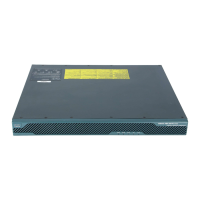21-11
Cisco ASA 5500 Series Configuration Guide using ASDM
OL-20339-01
Chapter 21 Configuring OSPF
Customizing OSPF
Valid values for this setting range from 0 to 255. The default value is 1. Entering 0 for this setting
makes the router ineligible to become the designated router or backup designated router. This setting
does not apply to interfaces that are configured as point-to-point non-broadcast interfaces.
• Check or uncheck the MTU Ignore check box.
OSPF checks whether neighbors are using the same MTU on a common interface. This check is
performed when neighbors exchange DBD packets. If the receiving MTU in the DBD packet is
higher than the IP MTU configured on the incoming interface, OSPF adjacency will not be
established.
• Check or uncheck the Database filter check box.
This check box to filter outgoing LSA interface during synchronization and flooding. By default,
OSPF floods new LSAs over all interfaces in the same area, except the interface on which the LSA
arrives. In a fully meshed topology, this can waste bandwidth and lead to excessive link and CPU
usage. Checking this check box prevents flooding OSPF LSA on the selected interface.
Step 13 (Optional) Click Advanced to edit the OSPF Interface Advanced Properties.
The Edit OSPF Interface Advanced Properties dialog box lets you change the values for the OSPF hello
interval, retransmit interval, transmit delay, and dead interval. Typically, you only need to change these
values from the defaults if you are experiencing OSPF problems on your network.
Step 14 Enter values for the following:
• Hello Interval—Specifies the interval, in seconds, between hello packets sent on an interface. The
smaller the hello interval, the faster topological changes are detected but the more traffic is sent on
the interface. This value must be the same for all routers and access servers on a specific interface.
Valid values range from 1 to 65535 seconds. The default value is 10 seconds.
• Retransmit Interval—Specifies the time, in seconds, between LSA retransmissions for adjacencies
belonging to the interface. When a router sends an LSA to its neighbor, it keeps the LSA until it
receives the acknowledgement message. If the router receives no acknowledgement, it will resend
the LSA. Be conservative when setting this value, or needless retransmission can result. The value
should be larger for serial lines and virtual links. Valid values range from 1 to 65535 seconds. The
default value is 5 seconds.
• Transmit Delay—Specifies the estimated time, in seconds, required to send an LSA packet on the
interface. LSAs in the update packet have their ages increased by the amount specified by this field
before transmission. If the delay is not added before transmission over a link, the time in which the
LSA propagates over the link is not considered. The value assigned should take into account the
transmission and propagation delays for the interface. This setting has more significance on very
low-speed links. Valid values range from 1 to 65535 seconds. The default value is 1 second.
• Dead Interval—Specifies the interval, in seconds, in which no hello packets are received, causing
neighbors to declare a router down. Valid values range from 1 to 65535. The default value of this
setting is four times the interval set by the Hello Interval field.

